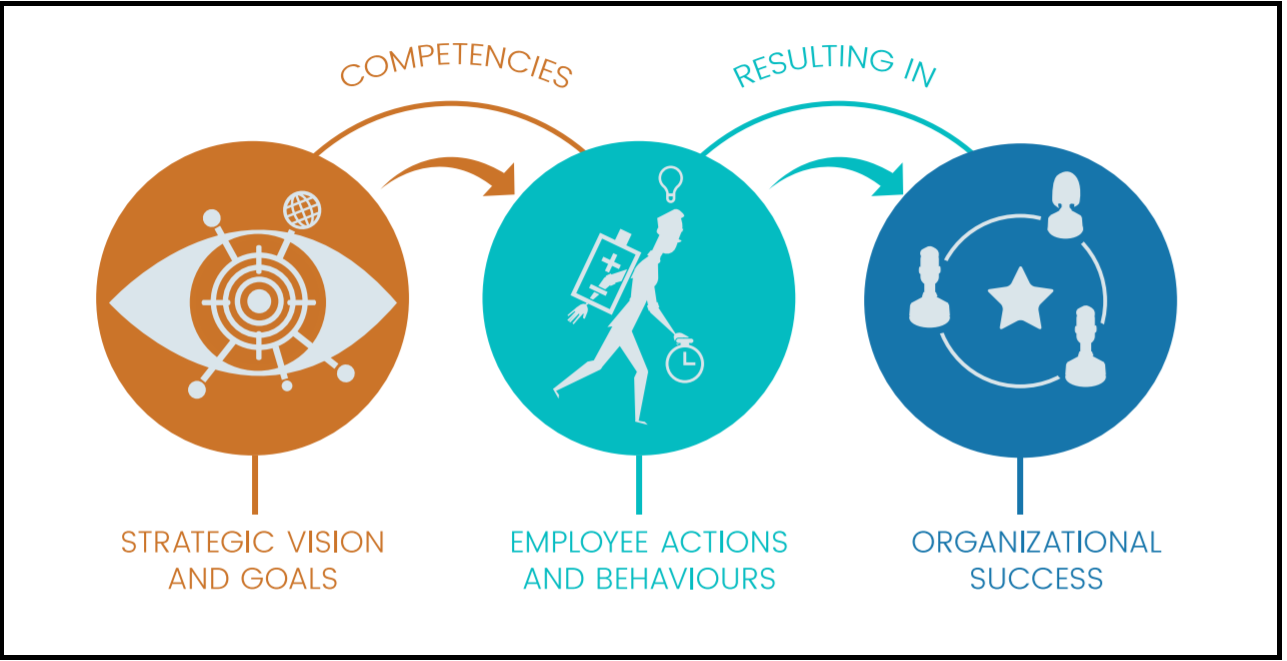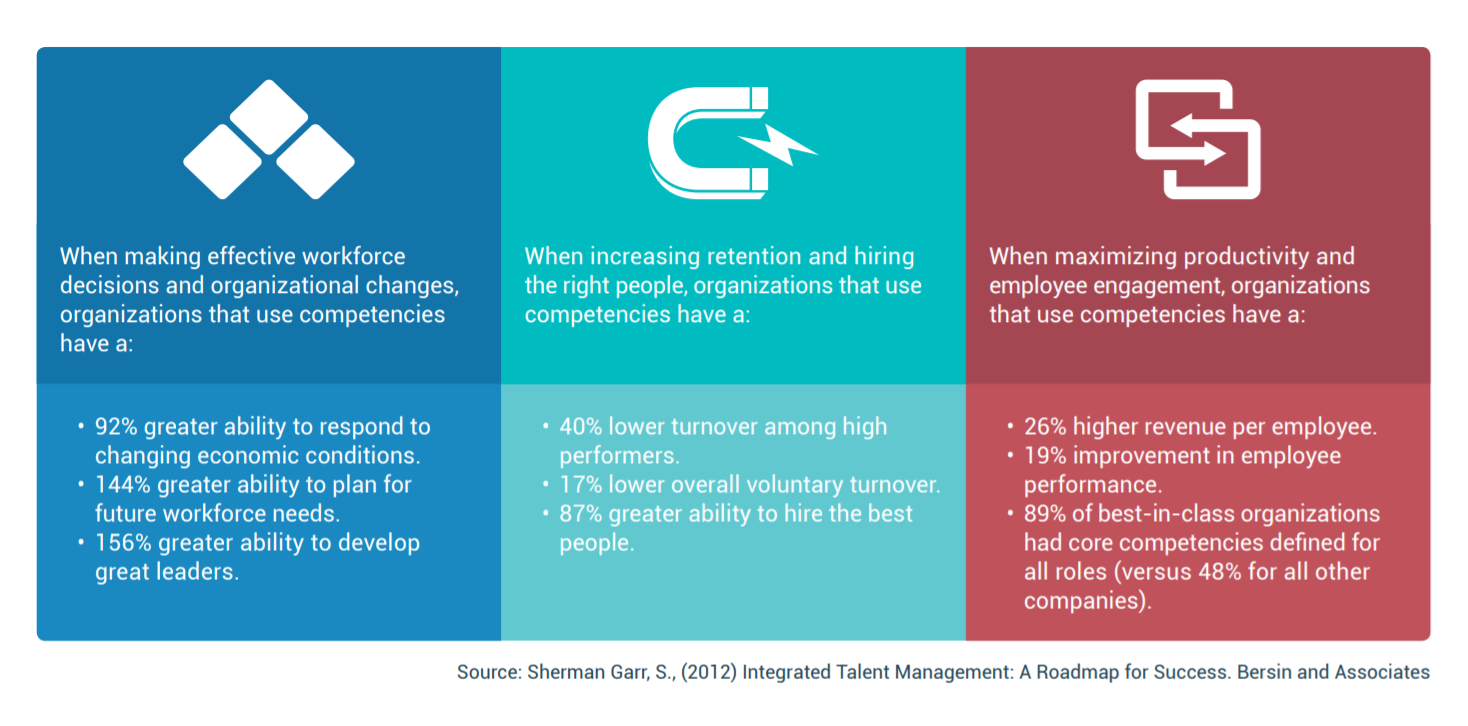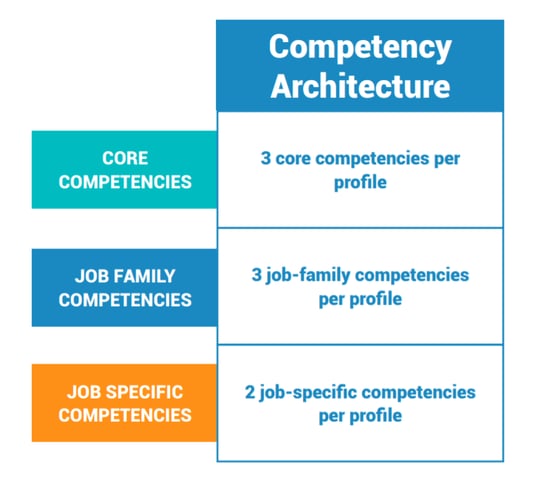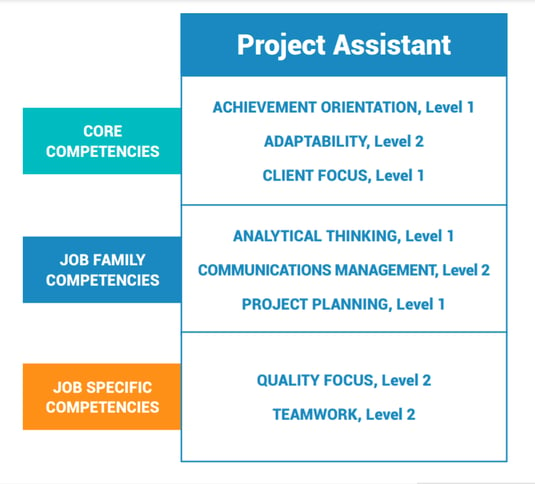Sarah Beckett
As a competency specialist, we’re often asked whether there is any difference between skills and competencies.
Are they just different words for the same thing, or do they function differently as talent-management tools?
This blog post is to help you better understand the difference between skills and competencies. In a hurry? Jump straight to your section of interest by clicking on a link (see below).
Article table of contents (jump to a section):
1. What are Skills?
2. What are Competencies?
3. How Are Skills and Competencies Similar?
4. What’s the Difference Between Skills and Competencies?
5. How Organizations Use Competencies
6. Why Use Competencies?
7. Different Types of Competencies with Examples
8. What is a Competency Framework?
i. What is Competency Architecture?
ii. Competency Profile Example
9. How to Apply Competencies in HR
i. 4 Ways That Multi-Level Competencies Improve HR Processes
10. Conclusion: Why Competencies Are More Useful Than Skills
i. Using Software to Implement Competencies Quickly and Effectively
What are Skills?
Skills define specific learned activities, and they range widely in terms of complexity. (“Mopping the floor” and “performing brain surgery” can both be classified as skills.)
Knowing which skills a person possesses helps us determine whether their training and experience has prepared them for a specific type of workplace activity.
What are Competencies?
Competencies identify the observable behaviors that successful performers demonstrate on the job. Those behaviors are the result of various abilities, skills, knowledge, motivations, and traits an employee may possess.
What are competencies?
Competencies take "skills" and incorporate them into on-the-job behaviors. Those behaviors demonstrate the ability to perform the job requirements competently.
Here’s an easy formula to remember what competencies are:
Skills + Knowledge + Abilities = Competencies
How are Skills and Competencies Similar?
In some ways, a skill and a competency are similar. On a basic level, they both identify an ability that an individual has acquired through training and experience.
But the two concepts are quite different in terms of the function they perform within the talent-management process.
What’s the Difference Between Skills and Competencies?
Skills give us the “what.” They tell us what types of abilities a person needs to perform a specific activity or job. Sadly, skills don’t give us the “how.”
For example: How does an individual perform a job successfully? How do they behave in the workplace environment to achieve the desired result?
Think of skills as one of three facets that make up a competency. The other two are knowledge and abilities. Skills are a component of a competency but a competency is never part of a skill.
How Organizations Use Competencies
There are several ways that any organization can effectively use quality competencies to achieve its hiring, retention and business goals.
To succeed on the job, employees need to demonstrate the right mix of skills, knowledge, and on-the-job ability. A well-structured, multi-level competency defines each of these elements in terms that allow managers and HR professionals to observe and recognize these behaviors.
Competencies give HR professionals and managers the tools they need at every step of an employee’s journey – from candidate through to development and promotion.
Below are a few ways that an organization can use competencies:
Job Descriptions
Adding competencies to job descriptions (competency-based job descriptions) helps unify all descriptions and positions across the organization under a common framework.
This provides structure to the organization’s HR programs, and allows HR personnel to get a much better grasp on the levels, roles, and dependencies between jobs in their organization.
A competency-based job description can now be linked to an organization’s interview process so its interview questions are created based on the competencies connected to the specified job description.
Interview Questions
By linking interview questions to competencies, candidates can now be asked questions that help demonstrate their experience in a specified competency area. These are called competency-based interview questions or behavioral interview questions.
Assessments
Self/180/360 assessments using specific behavioral examples that help employees and managers understand what successful performance looks like at different levels of proficiency.
In-House Career Progression
Close competency gaps and build career paths for employees. When your competencies mapped to every job, there can be total transparency on which specific behaviors and skills, at what levels, your employees need to demonstrate in order to progress their careers internally (or even reach their dream job).
Why Use Competencies?

Regardless of your industry or organizational size, using competencies can help you be better prepared to do the following:
- Tackle evolving job markets
- Hire the best people
- Develop effective leadership
- Improve employee performance

When making effective workforce decisions and organizational changes, organizations that use competencies have a:
- 92% greater ability to respond to changing economic conditions
- 144% greater ability to plan for future workforce needs
- 156% greater ability to develop great leaders
- 40% lower turnover among high performers
- 17% lower overall voluntary turnover
- 87% greater ability to hire the best people
When maximizing productivity & employee engagement, organizations that use competencies have a:
- 26% higher revenue per employee
- 19% improvement in employee performance
- 89% of best-in-class organizations had core competencies defined for all roles (versus 48% for all other companies)
Different Types of Competencies with Examples
Below are the 3 different types of competencies:- Behavioral competencies communicate the softer, inherent or natural behaviors of your employees.
- Example: Creativity and Innovation can be a behavioral competency for an agency.
- Technical competencies express the application of crucial skills and knowledge required for success in specialized job fields.
- Example: Strategic Sales Planning can be a technical competency for an organization. It would be applicable to those who work in the Sales Department.
- Leadership competencies capture the essential aspects of effective leaders and translate them into measurable behaviors.
- Example: Nurturing Innovation can be a leadership competency for a company
Below is a table showing additional competency examples based on the type of competency and the related competency definition.
| Competency Type | Competency | Definition |
| Behavioral | Information Gathering | Locating and collecting data from appropriate sources and analyzing it to prepare meaningful and concise reports that summarize the information |
| Client Focus | Providing service excellence to internal and/or external clients | |
| Decision Making | Using critical thinking, good business sense and organizational values to make decisions involving varying levels of risk and ambiguity | |
| Technical | Sales - Account Management | Building long term, value-based relationships with accounts, developing business and maximizing the revenue they generate while reducing the time and costs in managing them |
| Accounting & Finance - Auditing | Applying and understanding of auditing concepts and methodologies for internal and external audits | |
| Human Resources – Talent Management | Supporting, developing, retaining and engaging a workforce by creating, implementing and maintaining talent management solutions (e.g., employee engagement, succession planning, learning and development, assessment, planning) |
|
| Leadership | Embracing Diversity | Recognizing, valuing, and leveraging the unique perspectives, experiences, and talents of every individual; promoting cross-cultural understanding, fairness and inclusion throughout the organization |
| Nurturing Innovation | Creating a welcoming environment that encourages different perspectives and new ideas, building a culture of curiosity, openness, and creativity across the organization and the wider community | |
| Inspiring Others | Energizing and inspiring others to strive for excellence and commit to common goals and purposes, creating a sense of self-efficacy, resilience, and persistence in followers |
What is a Competency Framework?
A competency framework is a competency system implemented within an organization.
The framework consists of the goals of the system, the competency architecture, the competencies and competency profiles, the overall plan for the competency initiative, including the standards and processes for determining an initiative’s success.
What is Competency Architecture?
A competency architecture describes a simple set of rules that help you select competencies for every job in a consistent way. It describes how the competency profiles will be designed for your entire organization, including the format for displaying the competency profile and the content for the profile.
Having a competency architecture serves as a blueprint that ensures each job profile is built the same way and relates to other job profiles across the organization logically and predictably.
An organization’s competency architecture can include up to three levels: 
Core competencies: These competencies are shared by every job in the organization. They define the organization’s key values, strengths, and differentiators.
Job-family competencies: These competencies are shared by a specific group of jobs that perform common functions and form a logical group for development.
Job-specific competencies: These competencies define what is required to perform a specific job. So while ‘cash management’ might be a competency shared by every job in the finance job family, ‘leading change’ might be a competency that only the CFO needs to demonstrate.
Competency Profile Example
A competency profile is a selection of competencies with specified proficiency levels required for successful performance in a particular job.
Below is a competency profile example for a Project Assistant position:

| Competency Type | Competency | Competency Level |
| Core Competencies |
Adaptability |
Level 2 |
|
Client Focus |
Level 1 | |
|
Achievement Orientation |
Level 1 | |
| Job Family Competencies | Analytical Thinking | Level 1 |
| Communications Management | Level 2 | |
| Project Planning | Level 1 | |
| Job Specific Competencies | Quality Focus | Level 2 |
| Teamwork | Level 2 |
How to Apply Competencies in HR
Skills are an important part of any job profile. But they’re not robust or nuanced enough to guide talent-management activities. To manage the talent lifecycle, you need a system that’s consistent, structured, progressive, and unifying.
Well-defined, multi-level competencies are designed to provide a strong but flexible foundation that links every HR activity.
This starts by incorporating them into employees' job descriptions (quality job description software can help with this task). For further info on that, register to see a demo of our newest software Quinto.
Once they're implemented and integrated to job descriptions, competencies can have a huge impact on your organization's HR processes.
4 Ways That Multi-Level Competencies Improve HR Processes
- Consistency. Skill definitions—particularly for technical skills—are often pulled from a variety of sources, and as a result, they lack consistency.
- A competency dictionary defines these types of skills in consistent terms so that employees can see how their skills, knowledge, and abilities align with their own position as well as others in the organization.
- A competency dictionary defines these types of skills in consistent terms so that employees can see how their skills, knowledge, and abilities align with their own position as well as others in the organization.
- Structure. Competencies bring structure to HR activities that conventional skill definitions can’t match. Competencies were designed to fit into an architecture that spans the entire organization and lends structure to different departments, teams, and other business units.
- Progression. Unlike skill definitions, multi-level competencies define a specific skill at different levels of expertise and proficiency. Defining each of these proficiency levels is an invaluable tool for helping employees understand and take control of their career progression.
- Coordination. A subset of competencies, called “core competencies,” is designed to articulate the key values and capabilities that form the organization’s competitive advantage in the marketplace.
- Core competencies are shared by every employee in the company—from entry level to CEO—and bring greater unity, purpose, and coordination to the organization. See our 6 Key Steps to Selecting Core Competencies.
Conclusion: Why Competencies Are More Useful Than Skills
Competencies are more detailed than skills and take a person's knowledge and abilities into account to determine whether a person has the right behaviors to succeed in their job roles.
But because they have an internal and relational logic, using competencies as a foundation for talent management requires greater rigor and care than simply hunting for people that have the right skills.
Using Software to Implement Competencies Quickly and Effectively
In the past, the additional work involved in using competencies to define job success made many organizations hesitate to adopt them.
But more recently, the process of building and deploying comprehensive competency architecture to support the organization has been revolutionized by competency management software solutions like HRSG’s CompetencyCore.
Replacing spreadsheets and paper-based processes with software enables organizations to create, deploy, and maintain complex competency architecture more quickly and easily.
The best way to see our competency management system in action is to schedule your no-obligation demo. But if you're not quite ready to see it in action, be sure to check out our free Competency Toolkit.
Want to learn more about using competencies? Get started with our Competency Toolkit:
Download your Competency Toolkit using the form below. Downloaded over 14,000 times by professionals like you.
Learn More About Competencies:
Post last updated: February 26, 2021

Submit a Comment